Dark dining rooms divide people hard. Half think they’re the height of sophistication, the other half worry they’ll feel like eating in a cave. And honestly? Both can be right depending on how you actually execute the moody look.
The difference between “intimate restaurant vibes” and “why is this room so depressing” comes down to understanding that moody doesn’t mean dark for the sake of being dark. It means creating atmosphere through intentional contrast, layered lighting, and materials that feel rich rather than just… dark.
When moody dining rooms work, they make every meal feel like an occasion. When they don’t, nobody wants to eat there.
What Makes Moody Actually Work (Instead of Just Looking Dark)
Successful moody dining rooms are about atmosphere and contrast, not just painting everything black and hoping for the best.
Lighting Is Literally Everything – You can’t have moody without multiple light sources at different heights creating pools of illumination and shadow. One overhead fixture will just make a dark room feel dim.
Texture Prevents Flatness – Dark colors without texture just look like painted walls. Velvet, leather, brass, textured plaster—these create the depth that makes moody feel luxurious.
Reflective Elements Break Up Darkness – Mirrors, glass, polished metals, and glossy finishes bounce light around and prevent spaces from feeling like black holes.
Quality Materials Matter More – Cheap finishes in dark colors look terrible. Rich materials in dark tones look expensive. There’s no faking this one.
Making Moody Work for Daily Life
Dark dining rooms aren’t just about aesthetics—they need to function for actual meals and gatherings.
Consider Natural Light Reality – North-facing rooms with minimal windows need different approaches than sun-drenched spaces. Work with what you’ve got.
Think About Your Entertaining Style – If you mostly eat breakfast in here, maybe rethink going full moody. These spaces shine (ironically) for evening dinners and gatherings.
Plan for Flexibility – The best moody rooms can adjust lighting intensity for different occasions rather than being locked into one atmosphere.
Don’t Forget Practical Needs – You still need to see your food, read menus, and not trip over furniture. Moody has limits.
Moody Dining Room Ideas
Deep Charcoal with Brass Warmth
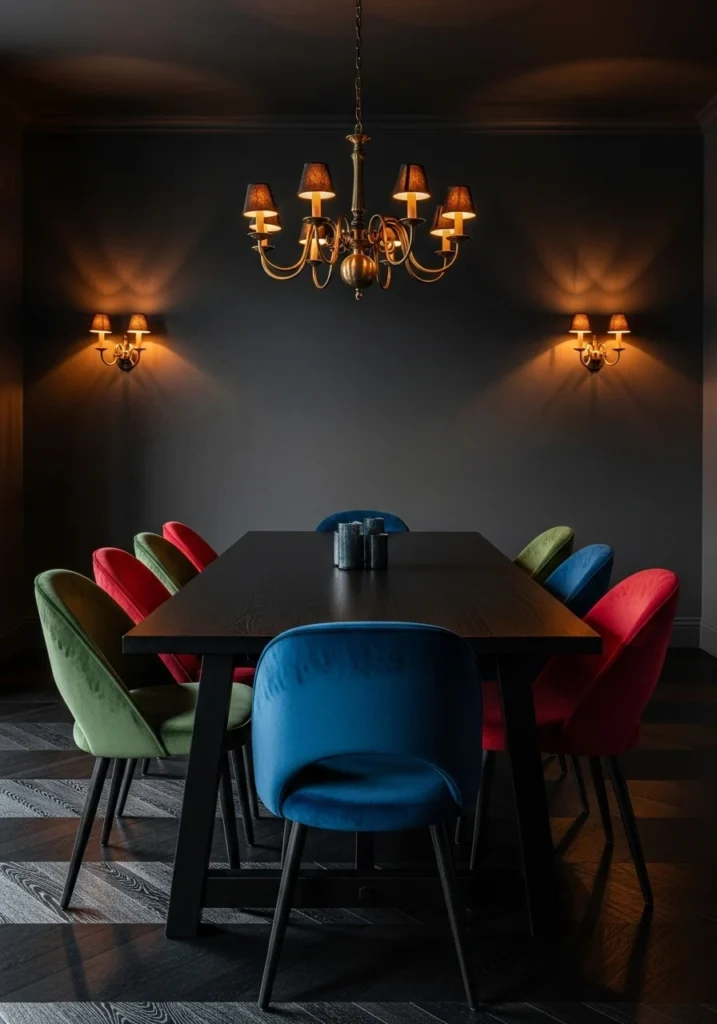
Start with matte charcoal textured plaster walls—the texture is crucial for preventing flatness. Add long black oak table with jewel-toned velvet chairs and oversized brass chandelier with warm dimmable bulbs.
Layer in brass sconces and dark herringbone floors. The key is using warm metals to balance the darkness and creating multiple light sources.
This works for people who want serious drama but still need the space to feel inviting rather than oppressive.
Crystal Chandelier Drama
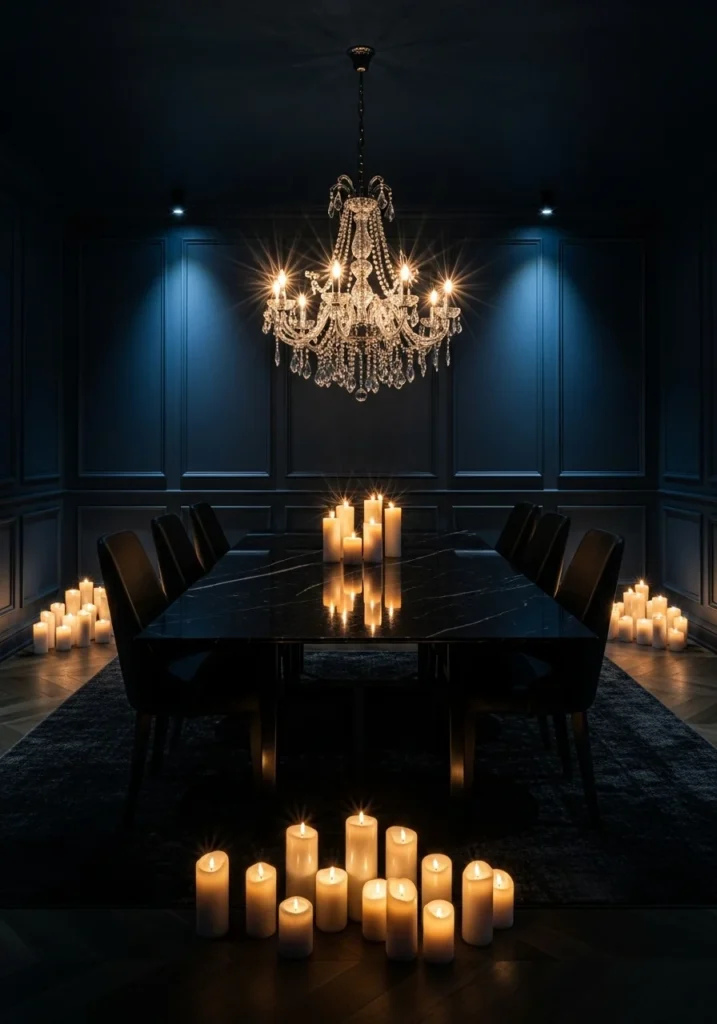
Go dramatic with navy paneled walls and polished marble table with high-back leather chairs. The star is an oversized crystal chandelier that catches and refracts light everywhere.
Add floor candles and subtle ceiling wash lighting. The crystal becomes the focal point that makes the dark walls feel intentional rather than just… dark.
Perfect for formal dining rooms where you want old-world glamour with moody sophistication.
Layered Atmospheric Lighting
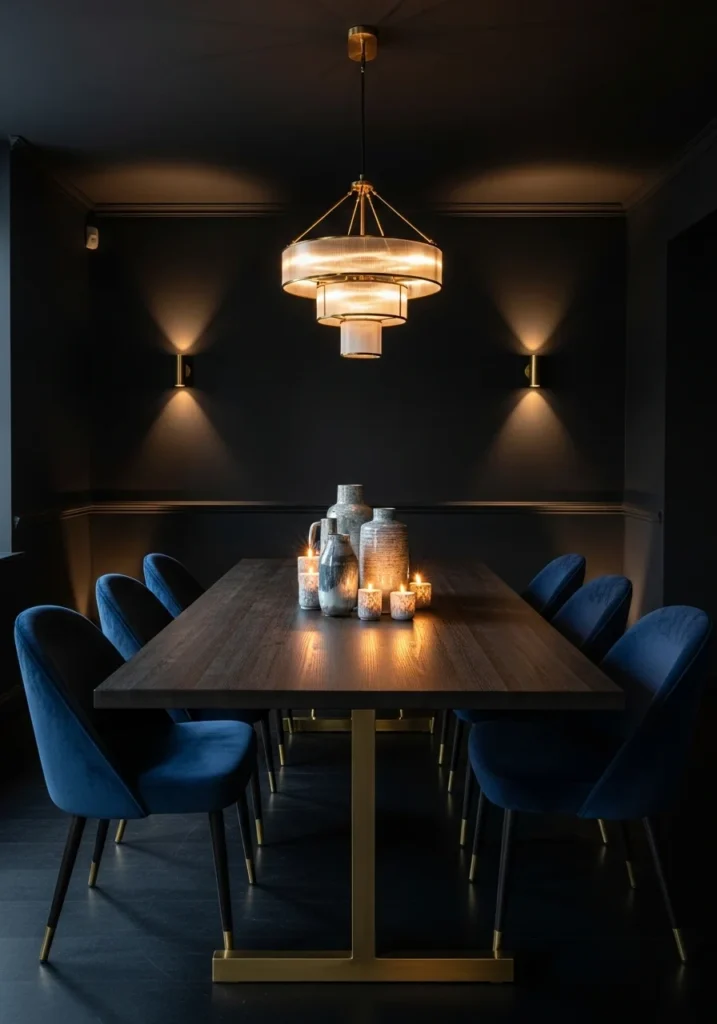
Paint walls actual black (brave, I know) but save it with seriously layered lighting—pendant chandelier, brass sconces, tabletop candles, and uplighting that grazes walls.
Use smoked oak table with brass base and indigo velvet chairs. The lighting layers create this incredible depth that makes black walls feel atmospheric instead of flat.
This works when you’re committed to the moody aesthetic and willing to invest in proper lighting design.
Velvet and Leather Tactile Mix
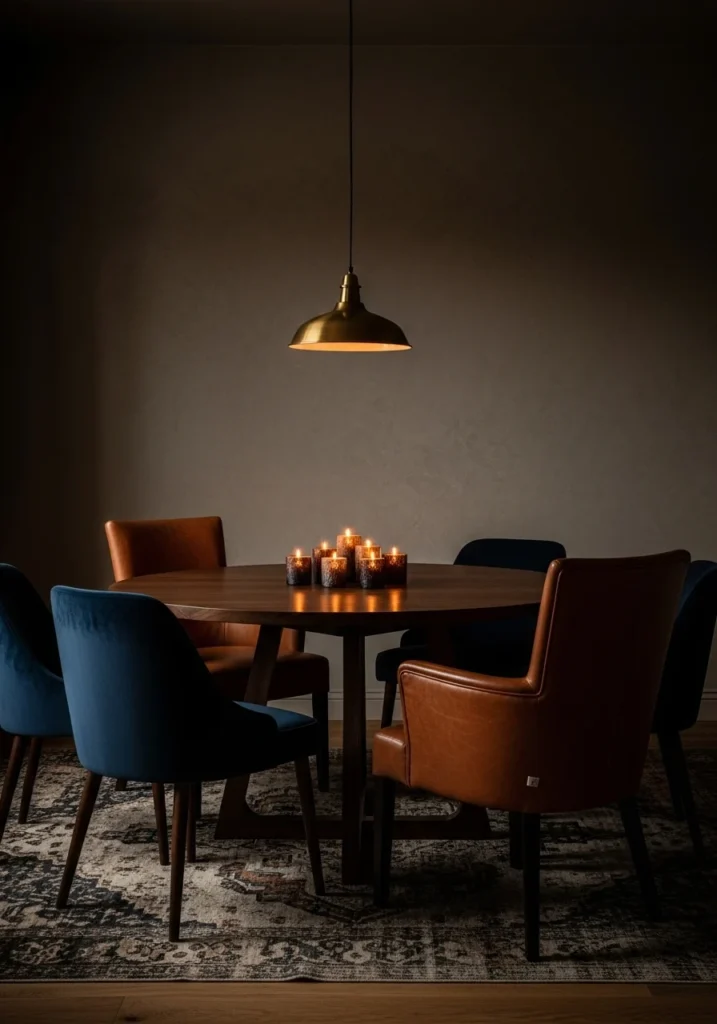
Combine midnight blue velvet chairs with cognac leather captain’s chairs around dark walnut table for incredible material richness.
Add textured plaster walls and low brass pendant with clustered candles. The material mixing creates visual interest that prevents the space from feeling one-note.
Great for people who want moody but also appreciate how different materials create sophistication.
Black Stone Table Centerpiece
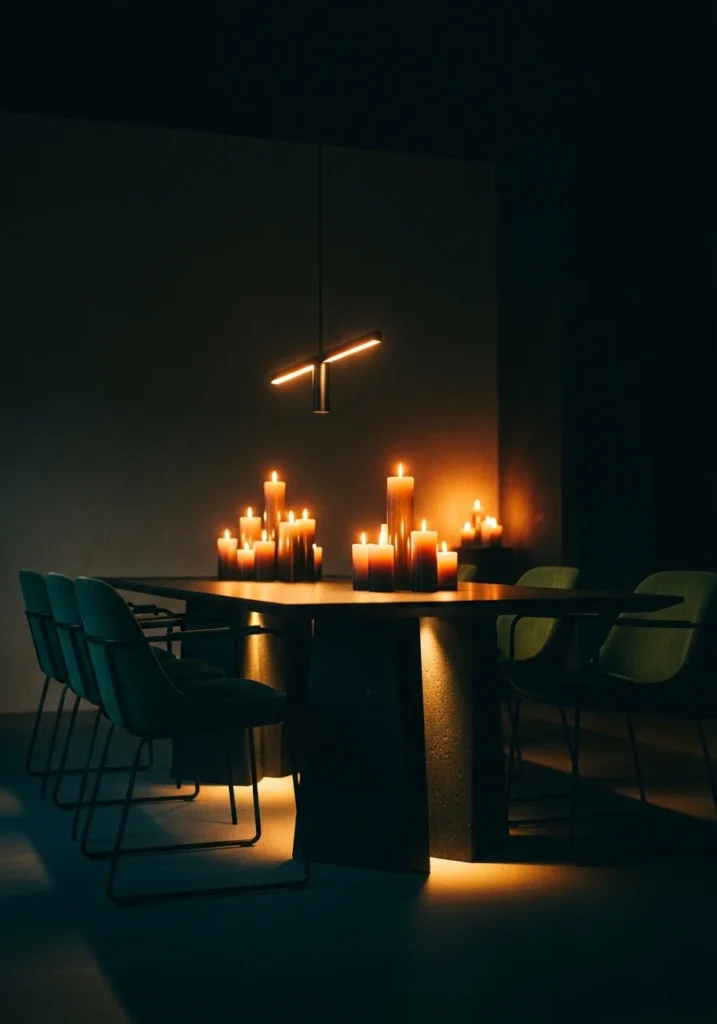
Make a matte black stone pedestal table the dramatic anchor with deep green suede chairs surrounding it. Keep lighting minimal but strategic—overhead pendant plus warm uplighting.
The sculptural table becomes the hero while subtle lighting keeps it from feeling too heavy. Amber candles soften the edges.
This approach works when you want one statement piece to carry the moody aesthetic rather than going dark everywhere.
Ebony Fluted Wood Texture
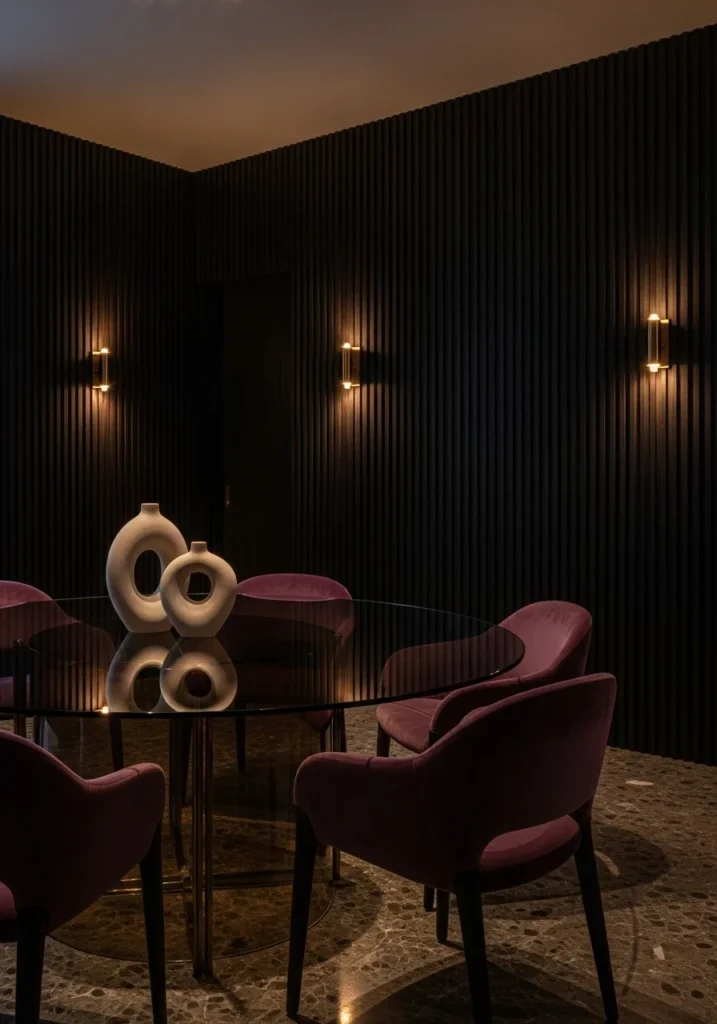
Install ebony fluted wood panels with brass sconces that cast dramatic vertical light streaks. Add smoked glass table and plum velvet chairs.
The fluted panels create incredible texture and shadow play that makes the darkness feel architectural rather than just painted. Polished stone floors reflect warm tones.
Perfect for people who appreciate how texture and light interaction create sophisticated moody atmospheres.
Bronze and Metallic Accents
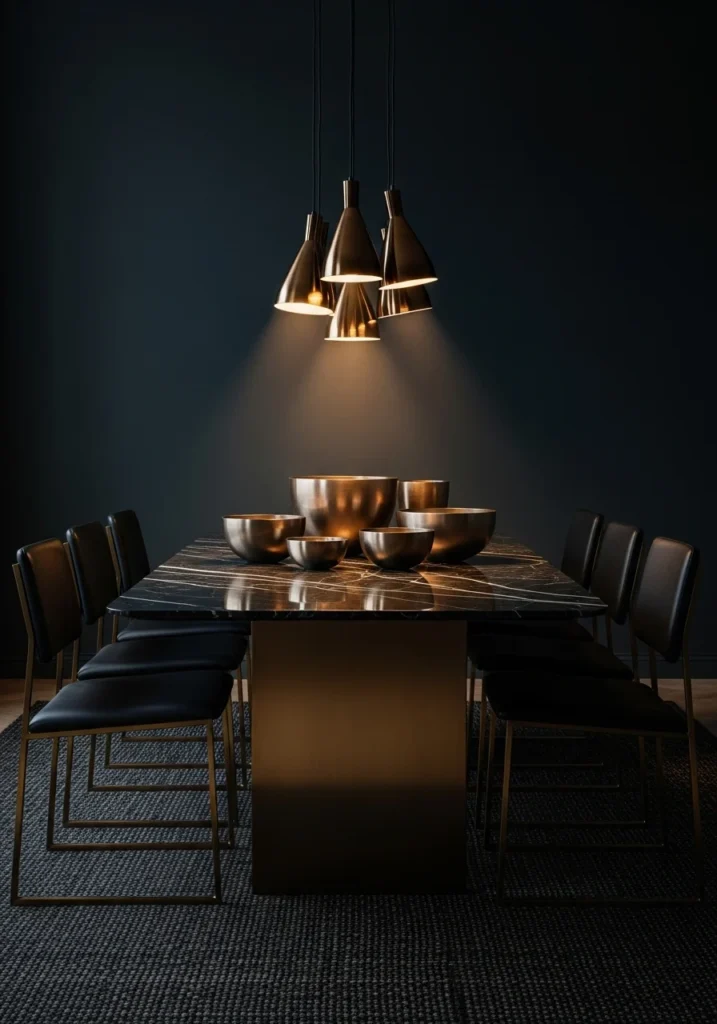
Use deep slate walls with brushed bronze dining table featuring marble top. Add black leather chairs with brass frames and bronze pendant cluster.
The bronze metallics throughout create this warm glow against the dark backdrop. Metallic bowls on table continue the theme.
Works well when you want moody sophistication with warmer metallic tones rather than cooler silvers.
Also Read: 15 Places You Can Add Decking That If You Want
Gallery Wall Art Integration
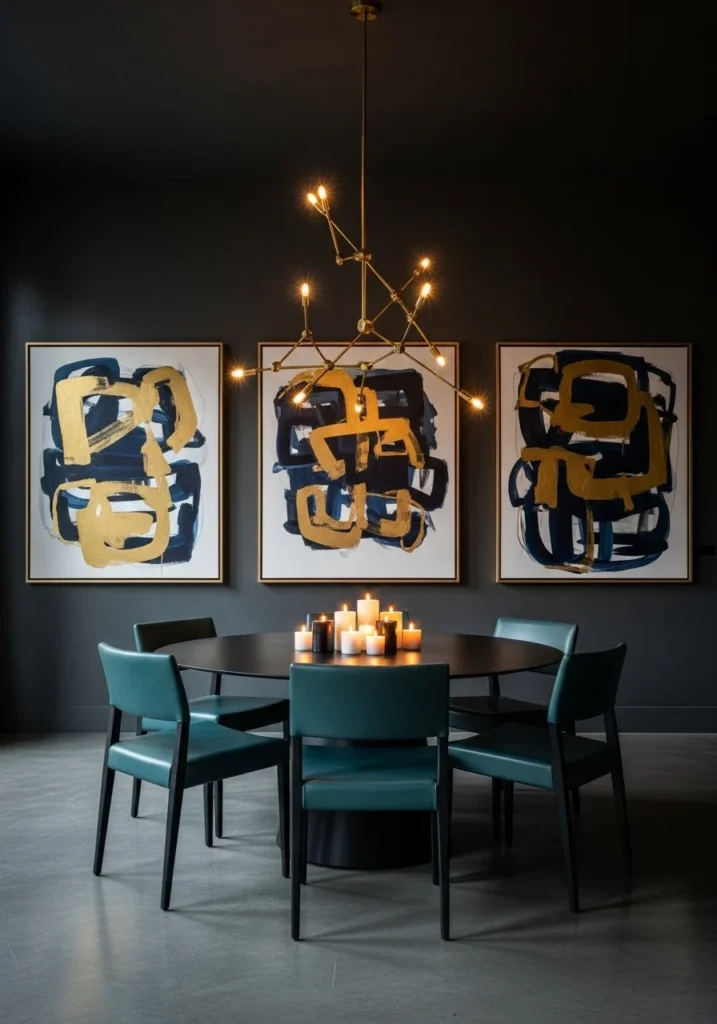
Cover charcoal walls with oversized abstract paintings in muted gold and navy for gallery-like sophistication. Use matte black round table with teal leather chairs.
The large-scale art provides visual interest and color that keeps dark walls from feeling oppressive. Sculptural brass chandelier adds warm lighting.
Perfect for art lovers who want their dining room to feel like a curated gallery space.
Smoky Mirror Reflections
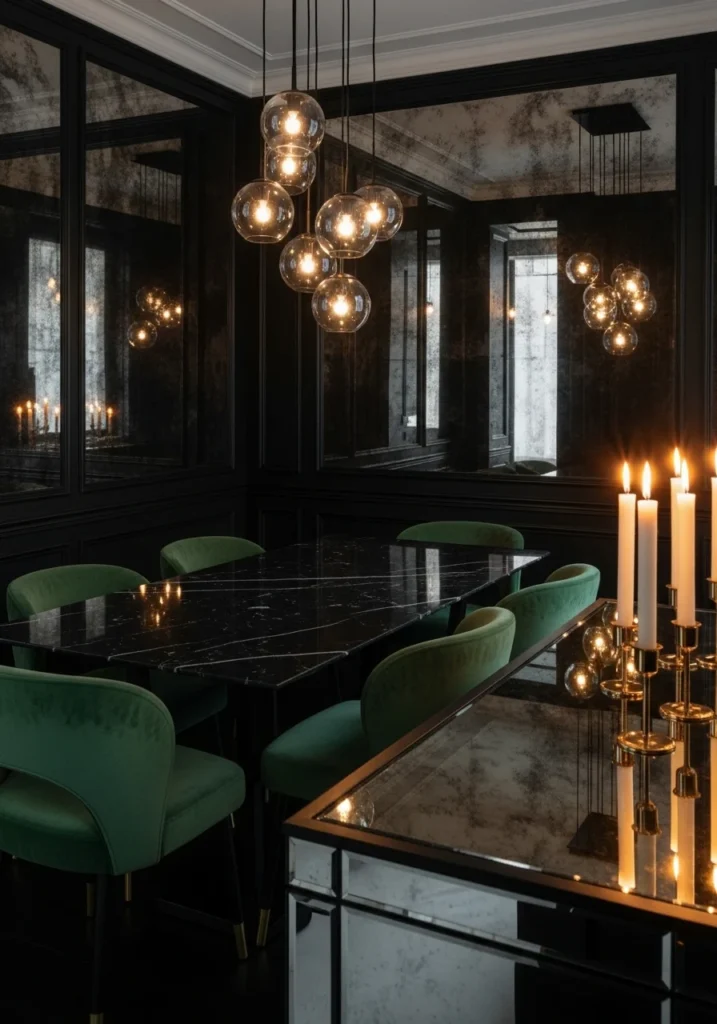
Install smoky antique mirrors in black paneled walls for depth and light reflection. Add black marble table with emerald velvet chairs and glass globe pendant cluster.
The mirrors create incredible depth and multiply light sources without bright reflections. Mirrored sideboard continues the reflective theme.
This approach uses reflection to create visual complexity that prevents moody from feeling flat or dark.
Romantic Candlelight Focus
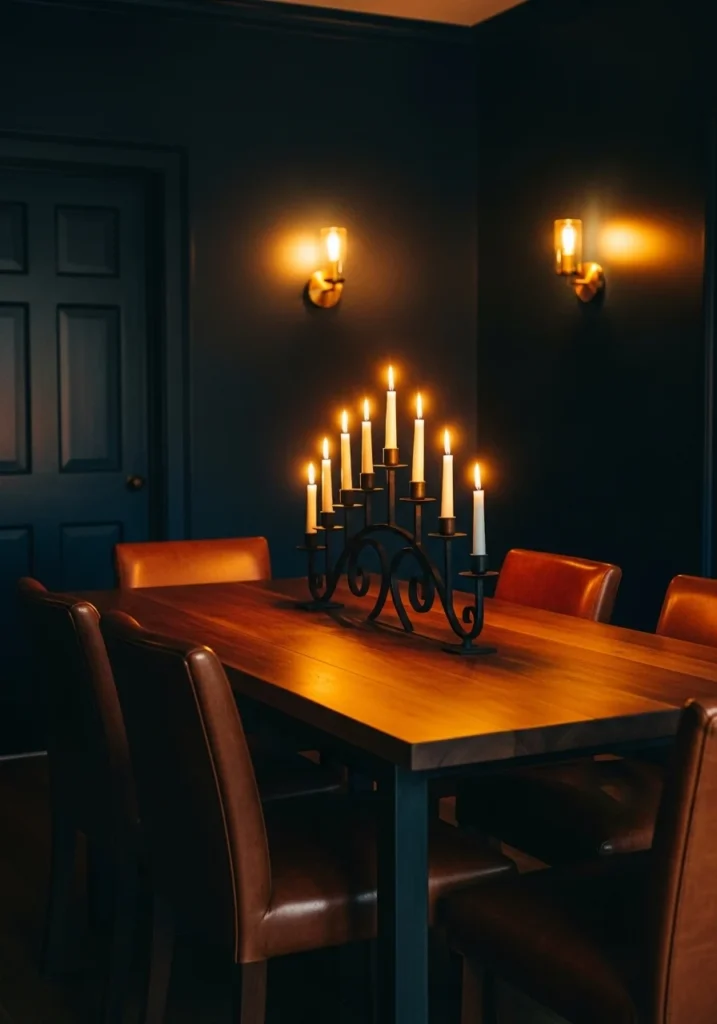
Center the whole design around dramatic candlelight—oversized wrought-iron candelabra with tall tapers on rustic walnut table surrounded by cognac leather chairs.
Deep navy walls and brass sconces support the candlelight focus. The flickering light creates this incredible romantic atmosphere.
Works for people who love the ritual of candlelit dinners and want that to be the room’s defining characteristic.
Dramatic Floral Centerpiece
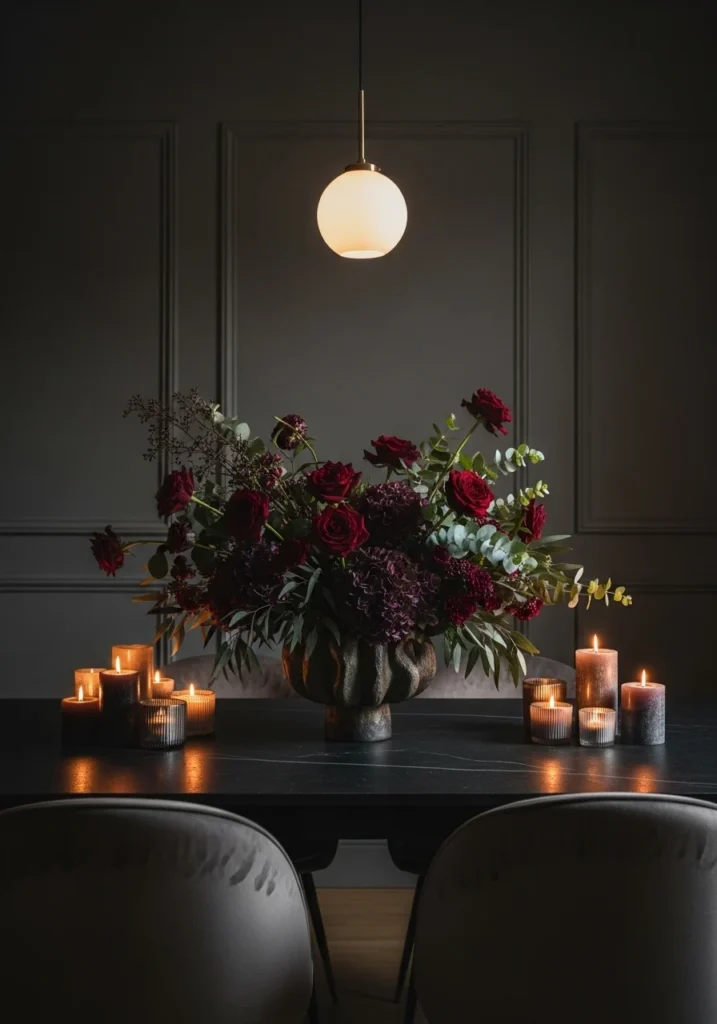
Use matte charcoal walls with black stone table and high-back velvet chairs, but add oversized sculptural floral arrangement—burgundy roses, dark hydrangeas, eucalyptus.
The dramatic florals provide organic softness against hard dark surfaces. Dimmed chandelier and layered candles complete the mood.
Great for people who want moody sophistication but also appreciate how organic elements soften dark spaces.
Velvet Drapes Cocoon
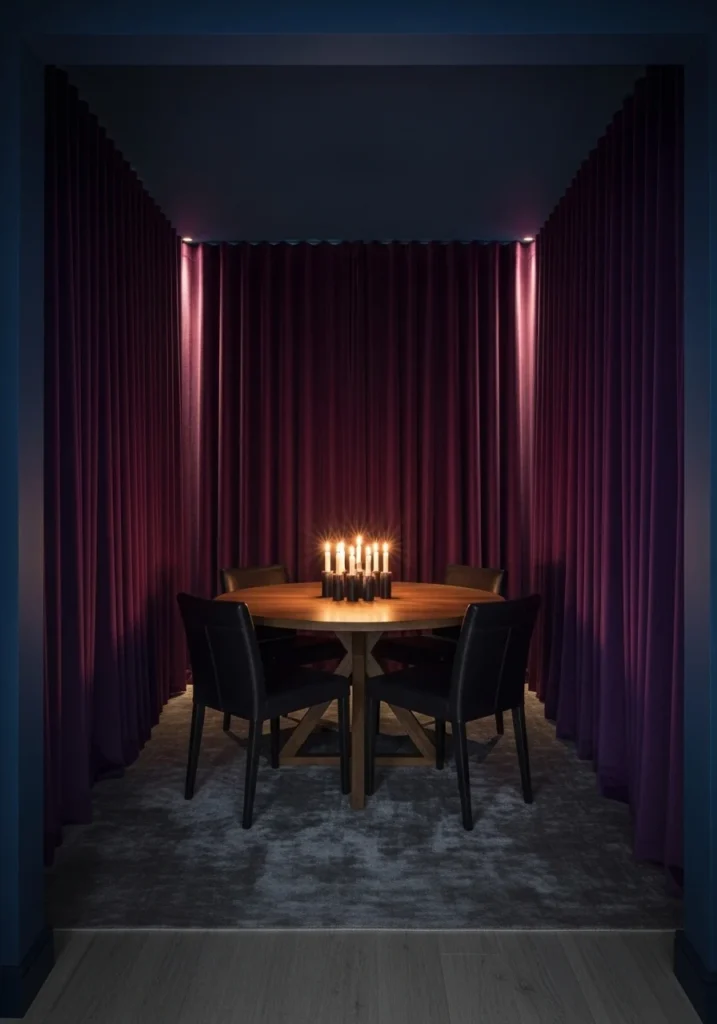
Create intimate cocoon with deep indigo walls and floor-to-ceiling plum velvet drapes that enclose the space. Add round oak table with leather chairs.
Hide uplighting behind drapery folds for diffused glow. Plush wool rug adds acoustic softening. Candle cluster provides central warmth.
This works when you want maximum intimacy and are comfortable with fully enclosed, cocooned dining atmosphere.
Natural Element Balance
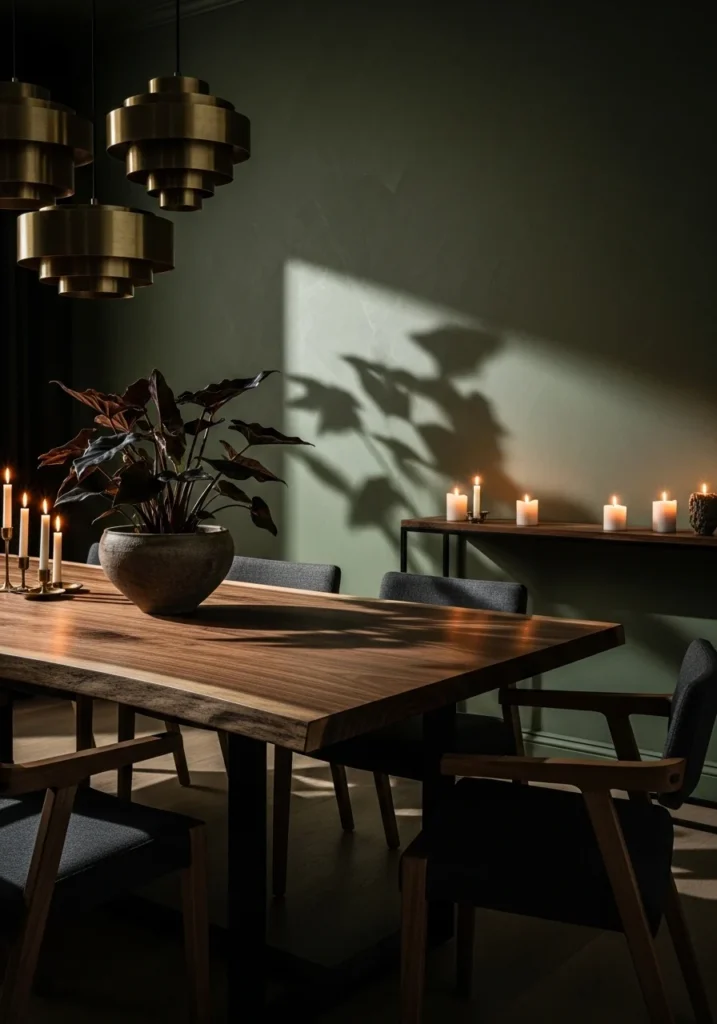
Balance forest-green walls with live-edge walnut table and charcoal linen chairs for organic moody aesthetic. Add stoneware and dark-leaf plants.
Layered brass pendants and candlelight create earthy warmth while natural materials prevent the dark palette from feeling artificial.
Perfect for people who want moody sophistication that still feels connected to natural materials and organic forms.
Luxury Tableware Detail
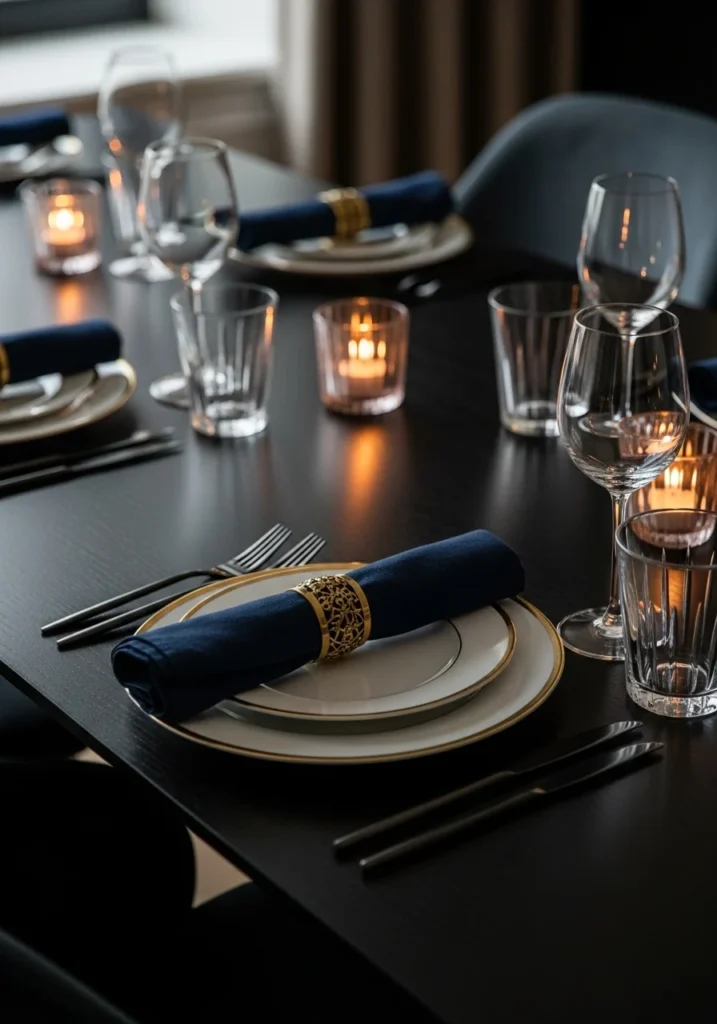
Focus on the table setting itself—fine porcelain with gold rims, crystal stemware, matte black cutlery, and navy linen with brass napkin rings against matte black table.
The luxurious table details create intimacy within the larger moody space. Candlelight dancing across surfaces provides warmth.
This approach works when your moody walls are the backdrop for creating intimate dining experiences through refined table styling.
The Real Secret to Moody Dining Rooms
Moody isn’t a color scheme—it’s a lighting strategy. You can have dark walls and still fail at moody if your lighting is wrong. But nail the layered lighting with quality materials, and suddenly dark walls become atmospheric rather than depressing.
Start with your lighting plan before choosing paint colors. Figure out where light will come from, how it will layer, and how it will interact with your materials. Then choose your dark palette.
And honestly? If you’re nervous about commitment, start with one dark accent wall and see how you feel living with it before painting the whole room charcoal.

